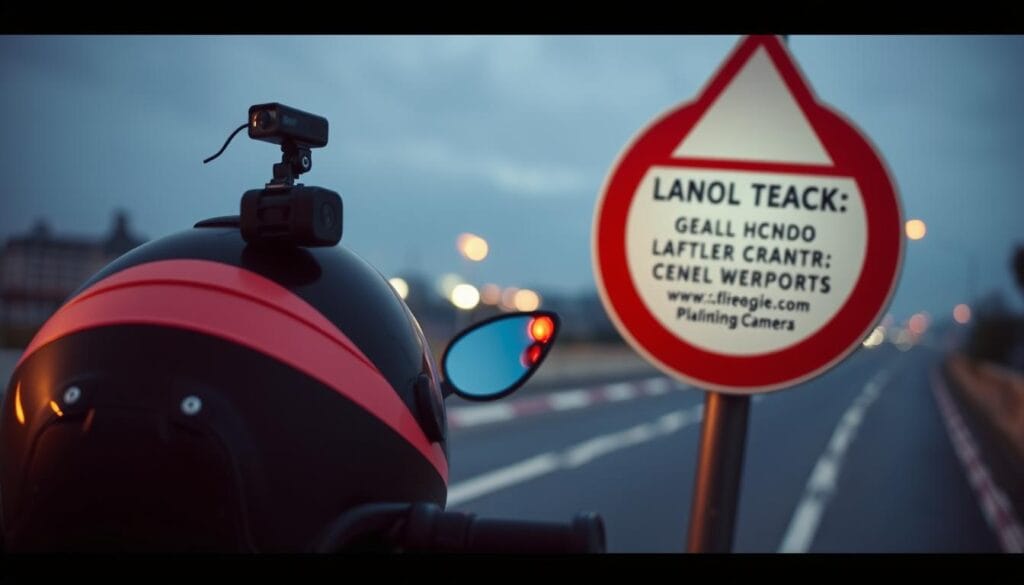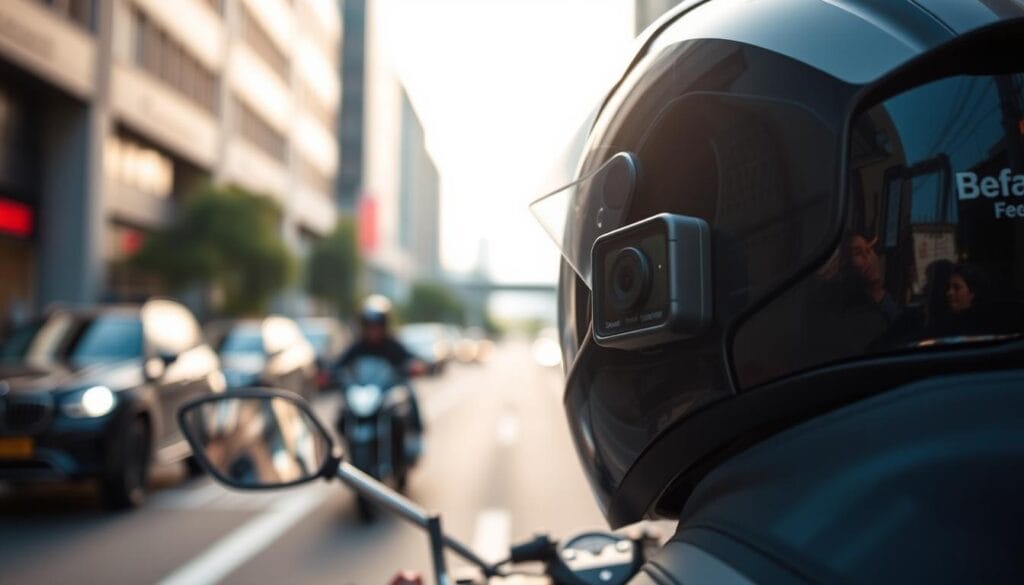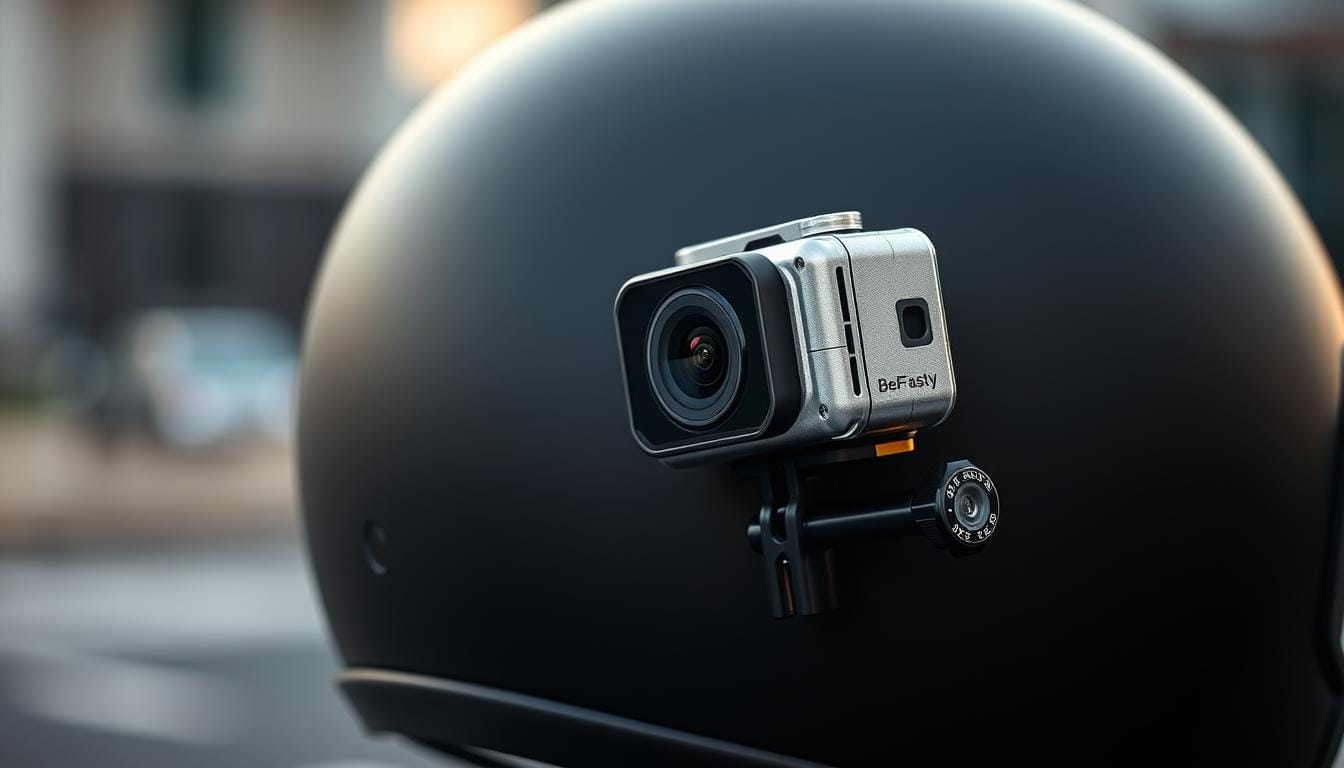Have you ever wondered if your motorcycle helmet camera is legal? These devices, known as motorcycle helmet cameras or motorcycle helmet cams, change how riders capture their journeys. But, there’s a catch. The rules vary by country, and breaking them can get you into trouble.
Key Takeaways
- Helmet camera legality hinges on where you ride, from state traffic laws to privacy statutes.
- Recording interactions with others may violate consent requirements in public spaces.
- Mounting hardware could interfere with helmet safety standards, risking citations.
- Accident footage from motorcycle helmet cams might help or hurt your case depending on local laws.
- Ignoring regional rules could void insurance coverage after collisions.
Understanding Motorcycle Helmet Camera Legality and Why It Matters
Motorcycle action cameras and systems are getting better at capturing rides and improving safety. But, with these advancements comes the need to know the law. It’s not just about avoiding fines. It’s about keeping yourself and others safe on the road.
The Growing Popularity of Motorcycle Helmet Cameras
Helmet cameras are more than just for fun. They help document accidents, share adventures, and provide evidence for insurance claims. Brands like GoPro and DJI lead the market, with over 40% of U.S. motorcyclists using them. Riders in states like California and Texas use them to record traffic, making the roads safer.
Legal vs. Illegal Use: What’s at Stake
- Illegal setups can void helmet safety certifications, leading to fines or citations.
- States like Florida penalize drivers using devices that obstruct vision, even if the camera is legal elsewhere.
- Mounting systems that shift weight could violate traffic laws, risking license suspension.
Privacy Considerations When Recording on Public Roads
Recording people without their consent can get you into trouble. Most states allow filming in public, but audio recording often needs consent. Always check local laws before sharing footage online. Even a simple vlog could break privacy laws if it captures people without their knowledge.
Motorcycle Helmet Camera Laws in the United States
Motorcycle helmet camera laws differ across the U.S. It’s important to know the local rules to use a motorcycle helmet camera mount legally. Here are some key guidelines by state.
States Where Helmet Cameras Are Explicitly Legal
Oregon and Washington allow helmet-mounted cameras. These states focus on safety, making sure motorcycle helmet camera mounts are secure. Always check the manufacturer’s guidelines for approved spots to avoid fines.
States With Restrictions on Mounting Options
In New York and Georgia, mounts must not block your view or interfere with safety gear. Don’t attach cameras to face shields. Instead, use side or rear mounts. Always check local laws before you install.
- New York: Prohibits obstructions on visors
- Georgia: Requires mounts to comply with helmet integrity standards
How Distracted Driving Laws Affect Camera Use
Adjusting a top motorcycle helmet camera while riding might break distracted driving laws. Use mounts that don’t need much adjustment to avoid legal trouble. Hands-free systems are best to stay legal.
California, Florida, and Texas Regulations
These states have their own rules:
| State | Key Rules | Compliance Tips |
|---|---|---|
| California | No audio recording without consent | Use a motorcycle helmet camera mount with clear video focus |
| Florida | No helmet modifications affecting safety | Choose lightweight mounts approved by manufacturers |
| Texas | Prohibits handheld adjustments | Install fixed mounts to avoid violations |
Always check with your state’s DMV for the latest rules. Being informed helps you enjoy helmet cameras without legal problems.
International Laws Regarding Motorcycle Helmet Cameras
Traveling riders need to check motorcycle helmet camera laws in every country. Laws differ a lot, so knowing the rules helps avoid fines or legal trouble.

- European Union: Most countries let cameras, but you need consent for audio. Germany and France say no to recording in private spots without permission.
- Canada: Federal rules say it’s okay to use cameras, but you must follow privacy rules. Ontario says no to recording in crowded places without telling people first.
- Australia: Recording in public is fine, but you need consent for audio. New South Wales says no to devices that block your view.
- Japan: Safety laws focus on helmet safety. Your camera mount can’t mess with the helmet’s crash protection.
- Thailand: Laws say you must show signs if recording in public. Some cities don’t let you record at night without police okay.
- India: Laws say no to recording audio without consent. Big cities like Mumbai have strict rules about sharing data.
Look for the best motorcycle helmet camera with adjustable mounts. This way, you can follow size limits in different places. Always check the local traffic authorities’ websites before you ride abroad. Some places, like Sweden, require you to turn off cameras in government buildings. Stay up to date to avoid fines and capture your rides safely.
Key Legal Considerations When Using Your Motorcycle Helmet Camera
Before you start using a motorcycle helmet camera, it’s crucial to understand the legal nuances. These protect both your rights and others’. This section covers consent requirements, evidence rules, insurance impacts, and safe installation practices.
Audio recording raises legal hurdles. In two-party states, you must get consent from everyone recorded. One-party states only need one participant’s agreement. If your motorcycle helmet camera with bluetooth includes audio, confirm local rules to avoid privacy violations.
Always disable audio in strict jurisdictions or use visual-only modes.
Footage from your camera can be vital in accident claims. But clarity matters. Courts often require clear timestamps and unedited files.
When shopping for models, check motorcycle helmet camera reviews to find devices with high-resolution video and secure storage. Avoid using footage taken illegally—it may be inadmissible in court.
Some insurers offer premium discounts for safety tech like helmet cameras. However, you must disclose their use during policy signup. If an accident occurs, provide unaltered footage to insurers promptly.
Look for motorcycle helmet camera reviews to select models with tamper-proof recording features.
Improper mounting can void safety certifications. Follow these rules:
- Use manufacturer-approved brackets to avoid shifting during rides.
- Ensure mounts don’t block air vents or interfere with helmet structure.
- Check that installations comply with DOT or ECE standards.

Regularly inspect mounts for wear, especially if using heavier models. Avoid generic third-party accessories—stick to gear listed in official motorcycle helmet camera reviews.
Conclusion: Riding Safely and Legally With Your Helmet Camera
Before you start using a motorcycle helmet camera, check the local laws. Laws about recording in public and using helmet cameras vary by state. It’s important to know the rules where you ride to avoid fines or legal trouble.
Make sure your camera setup is safe and doesn’t block your view. In places like California and Texas, you must use cameras without your hands. Also, be aware of laws about recording sound, as many states require consent.
Using a helmet camera can help make roads safer by capturing accidents. But, remember to respect people’s privacy. If you’re involved in an accident, your insurance might ask for the footage. Keep your videos safe and know what’s allowed.
Keep up with new laws by visiting your DMV or joining groups like the Motorcycle Riders Foundation. Sign up for alerts from your state’s transportation department to stay informed. New technology and laws come out quickly, so it’s important to stay current.
Using a helmet camera can make your rides safer if you do it right. Follow the rules, respect privacy, and keep your videos organized. This way, you protect yourself and others on the road.
FAQ
Are motorcycle helmet cameras legal to use in the United States?
The rules for using motorcycle helmet cameras vary by state. Some states allow them, while others have rules about how and when to use them. Always check your local laws to make sure you’re following them.
What should I look for when selecting the best motorcycle helmet camera?
Look for a camera with high-quality video (1080p or better), long battery life, and easy mounting. It should also be weather-resistant. Features like Bluetooth for sharing and controlling the camera are a plus.
How do privacy laws affect the use of motorcycle helmet cameras?
Privacy laws about helmet cameras depend on where you are. Many places require people to agree to being recorded, especially if you’re recording sound. Knowing these laws helps avoid legal trouble.
Can footage from my motorcycle helmet camera be used as evidence in an accident?
Yes, helmet camera footage can be important evidence in accidents. But, make sure the recording is legal. The admissibility of video can depend on how it was recorded and if it follows state laws.
What are the key features of a good motorcycle camera system?
A good camera system has clear video, is built to last, and mounts securely. It should also record sound. Features like GPS or Bluetooth can make your experience better.
What are the best practices for mounting my motorcycle helmet camera?
Mount your camera so it doesn’t block your view. Use mounts recommended by the manufacturer. Follow local laws about where and how to mount. Always make sure your helmet is safe and secure.
Are there any specific regulations for motorcycle helmet cameras in states like California and Texas?
Yes, California and Texas have their own rules for helmet cameras. In California, modifications must be safe. Texas says cameras can’t change the helmet’s design or how it works.
What should I do if I plan to travel internationally with my motorcycle helmet camera?
Check the laws in the countries you’ll visit. Each country has its own rules about helmet cameras. Learn about privacy laws, mounting rules, and any filming restrictions.

